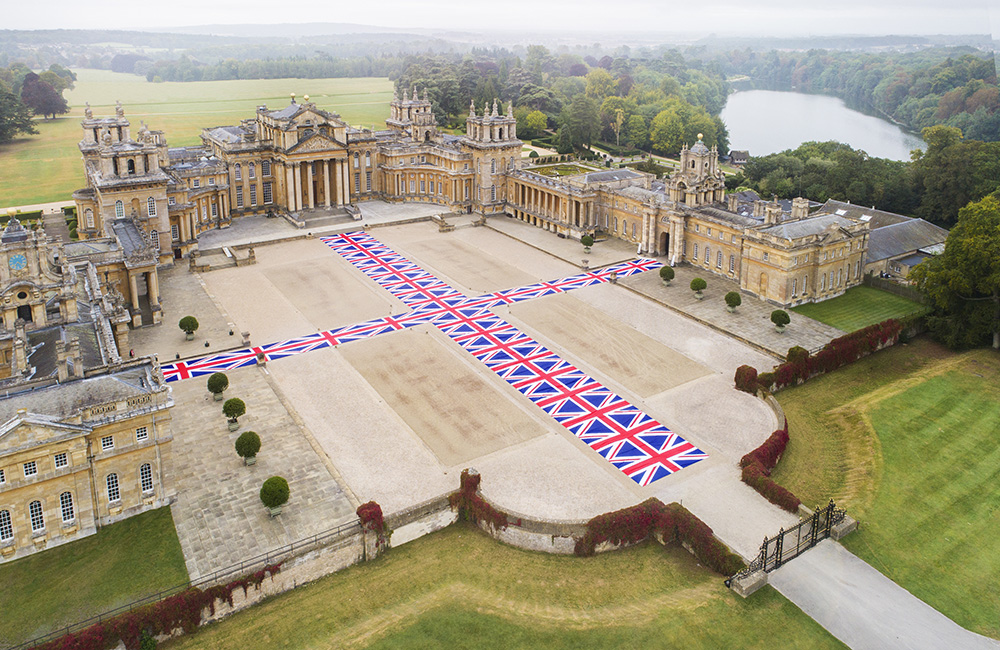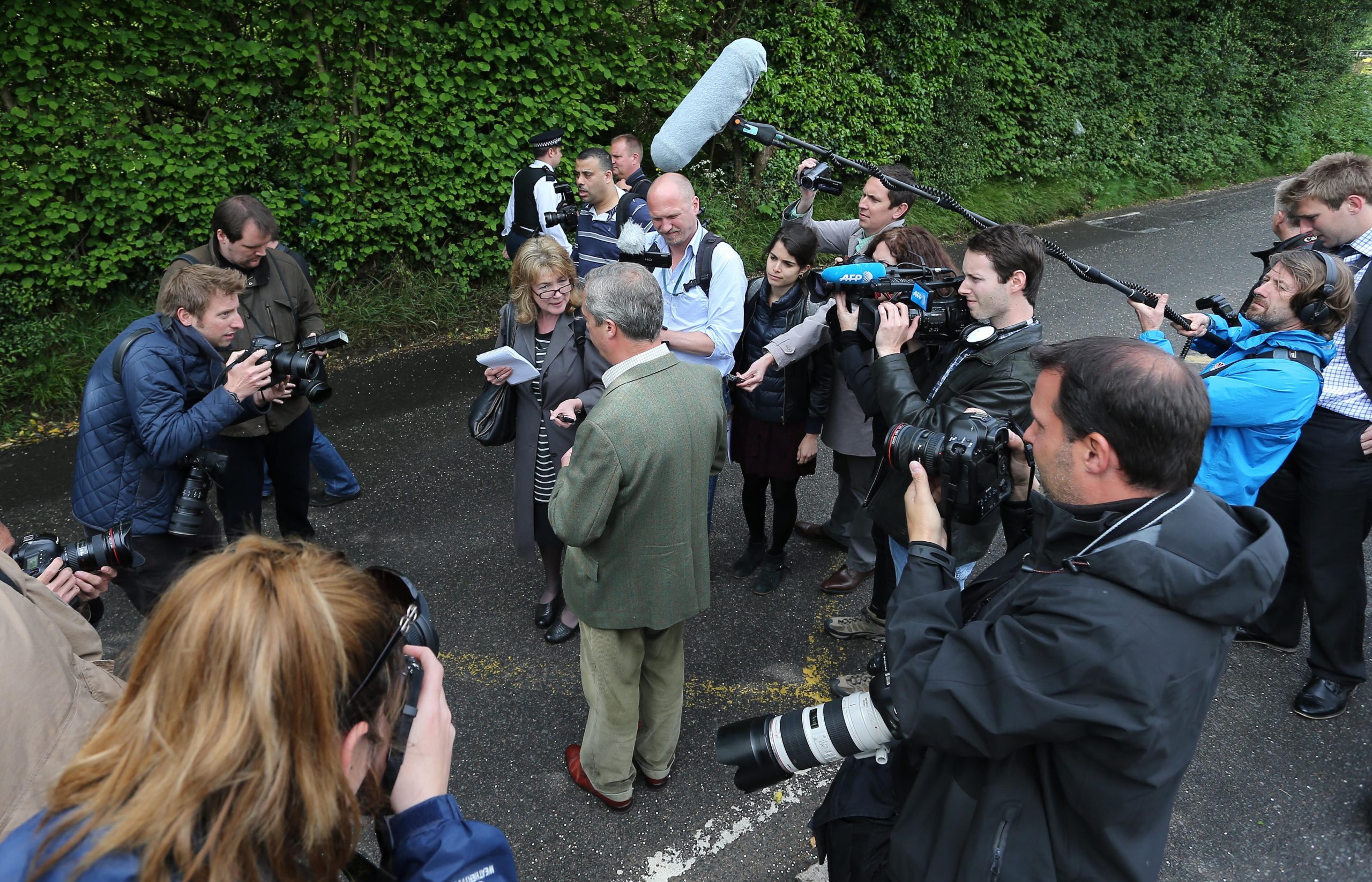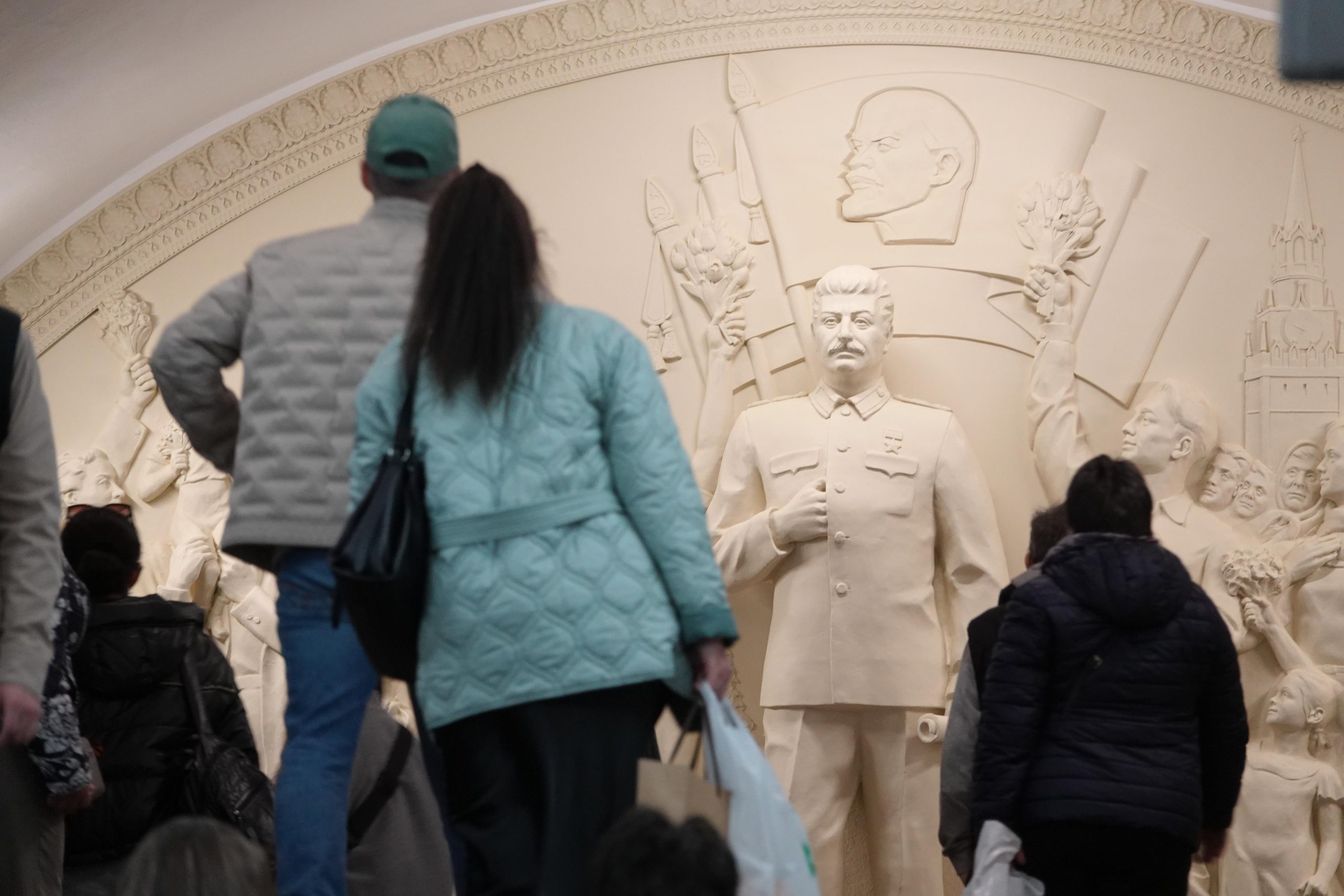[vc_row][vc_column][vc_single_image image=”112095″ img_size=”large” add_caption=”yes” alignment=”center”][vc_column_text][/vc_column_text][vc_column_text]In the lead-up to Maurizio Cattelan’s Victory is Not an Option exhibition, held at Blenheim Palace in the autumn of 2019, staff were nervous about its reception due to the controversial nature of the artist and his works. Despite initial apprehension the exhibition became one of the palace’s best received, and controversy actually occurred where it was least expected. Here is how those behind the exhibition managed the process. [/vc_column_text][/vc_column][vc_column][/vc_column][/vc_row][vc_row][vc_column][vc_column_text]Name of Exhibition: Victory is Not an Option
Artist: Maurizio Cattelan
Curated by: Blenheim Art Foundation
Date: 12 September – 27 October 2019
Venue: Blenheim Place
Brief description of the exhibition
The first major solo exhibition of artist Maurizio Cattelan’s work in the UK in 20 years, featuring a combination of his most iconic pieces and new works created in response to Blenheim Palace. Drawing on themes that resonate with the 18th Century palace’s martial and political history, the exhibition explores themes of nationality, wealth, war and the power of personality. See the exhibits on video here.
Art and censorship
This case study forms part of Index on Censorship’s work on art and censorship and explores the challenges of introducing contemporary, conceptual art into a heritage environment. The aim of this case study series is not to assess the artistic merits of an artwork, but rather to reflect on the steps taken by the curators to prepare staff and audiences for provocative and challenging work.
About Blenheim Palace
Designed by Sir John Vanburgh as a private house and home to the Duke of Marlborough, Blenheim Palace was intended, as the Blenheim Art Foundation says on its website, as “a testament of England’s supremacy over the French in a blaze of architectural glory that would rival Versailles.” It is the birthplace of Winston Churchill and where Hitler planned to live when he had conquered Britain. Asked in an interview for the Art Newspaper why he chose to come to Blenheim Cattelan said: “I had the invitation for the show a couple of years ago and was still thinking of it when, during his official UK visit, Trump met Prime Minister Theresa May there, instead of London. At that point, I could not be outdone.”
About the Blenheim Art Foundation
BAF was founded by Edward Spencer-Churchill, half brother of the Duke of Marlborough and collector of contemporary art, in 2014. Each year BAF invites a leading international artist to create an exhibition in the opulent surroundings of Blenheim Palace. “Showing work by living artists reminds us that the palace is not a place frozen in time, but a living, ever-changing national monument to culture of all kinds. … Through Blenheim Art Foundation’s exhibitions we hope to introduce new audiences to the work of some of today’s finest living artists, and provide seasoned art viewers with new ways of seeing contemporary artwork, in this most unique of settings” – Edward Spencer-Churchill.
What made it controversial?
Cattelan, described by The Art Newspaper as “Art’s most high-profile provocateur,” saitrises and lampoons the ideas of heroism, military prowess and national power. Placing Cattelan’s work in the palace alongside art that celebrates the Dukes of Marlborough, their family members and military achievements inevitably changes who sees the original art work and how it is perceived.
The BAF annual exhibition takes its place within a packed programme of events at Blenheim Palace and its grounds, including heritage tours of the palace and its artworks, fun runs, vintage car rallies, family circuses, Christmas events and the Blenheim Horse Trials. The programme employs 300 staff in the palace and attracts nearly a million visitors per year. Members of the staff team had expressed the following concerns:
- The work might have a negative impact on their core audience and damage the palace’s reputation
- Some guides had been concerned about their ability to do their work effectively since contemporary art was not their specialism
- Some guides also felt ill-equipped to respond to visitors who might be upset by the exhibits
- Particular iconic Cattelan works had elicited divisive responses across the staff team and had caused controversy in the past, notably Him, 2001, La Nona Ora, 1999, and Novecento, 1997
- Of these, Novecento, in which a taxidermied horse is hung from the ceiling, was the work that many of the staff found most problematic, especially given that the Blenheim Horse Trials were on during the exhibition run
In fact, although no-one had anticipated this in the run up to the exhibition, the installation of the Union Jack walkway taking the visitors to the entrance of the palace through the courtyard proved to be the most controversial piece (see Reflections below).
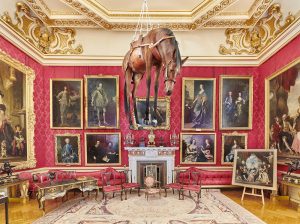
Maurizio Cattelan’s Novecento, 1997, in display at Blenheim Palace. One of the more controversial artworks. Credit: Tom Lindboe
What action was taken
Workshop with staff and guides: BAF and Index presented two half-day workshops, one for staff and one for guides. It gave the opportunity to respond to and discuss the artworks directly, and to raise concerns. For the guides, it was also an opportunity to rehearse how to respond to people who were upset about the work.
In addition a series of quotes from Cattelan were used as discussion points in small groups about the role of contemporary art, to encourage the team to get comfortable with talking to the public about the work:
- “I actually think that reality is far more provocative than my art”
- “There are times when being scandalous or provocative can help bring focus to issues of major concern”
- “The duty of art is to ask questions, not provide answers”
- “Art is a territory that everyone has the skills to explore”
Screenings of Maurizio Cattelan documentary for staff: BAF organised a number of screenings of the 2016 documentary Maurizio Cattelan: Be Right Back ahead of the opening.
Dedicated tour for palace staff: BAF led an after-hours tour of the newly installed exhibition for palace staff. It was an opportunity to discuss the work in situ and answer any questions.
Visitor information:
- Artwork booklet – free and handed out to all visitors as they enter the gates (back up supply in Great Hall). English only
- Exhibition and BAF “About” sheet in Mandarin – free sheet for Chinese individual visitors and tour groups who are Blenheim Palace’s second biggest demographic of visitor after English-speaking visitors.
- Room sheets – laminated sheets in rooms containing artworks
- Audio Guide – exhibition option available on long, short and highlights tour. English only
- Disclaimer warnings – alerting to the most sensitive works
- Information assistants – one on weekdays, two on weekends on duty at the exhibition to support the palace guides
- Further reading and feedback desk – dedicated desk located outside “America” where visitors can look at books about Cattelan and the subjects in the exhibition and leave feedback about the exhibition.
- Scripts for customer service: BAF provided a lot of FAQs for customer services who field all complaints
- Information pack for guides: BAF provided a full information pack with further information on each artwork, an explanation of the main ideas in the exhibition and biographical information on Cattelan.
- Opportunities for feedback: There were plenty of opportunities to feedback either in person to the information assistants or the BAF team, or on feedback forms. These were anonymous and very simple, placed right at the end of the exhibition, with very neutral language, asking how the work made you feel.
- Curators on site: In addition, to ensure the staff at Blenheim were supported if any difficult questions arose, a member of the BAF team was on hand, available to talk to visitors and support staff, especially the customer service.
- Dedicated information assistants: were on duty, ready to answer questions. They also approached people proactively and engaged people in discussion.
What happened
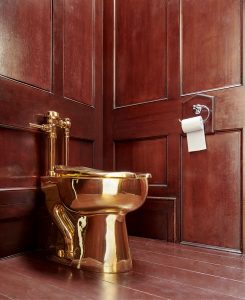
Maurizio Cattelan’s America, 2016, at Blenheim Palace before it was stolen. Credit: Tom Lindboe
The most controversial incident was something not anticipated when considering public response to the exhibition. Early in the morning of Saturday 14 September, two days after the show opened at Blenheim, “America”, the 18 carat gold fully functioning toilet, the centrepiece of the exhibition marketing strategy, was stolen. Cattelan commented to the NYT: “I want to be positive and think the robbery is a kind of Robin Hood-inspired action. I wish it was a prank.”
Visitor feedback: As anticipated the exhibition attracted a wide range of reactions, falling roughly into 50% in favour of the exhibition and 50% against. The installation that solicited the most criticism was, unexpectedly, the flags in the courtyard. This along with the success of the “crime scene” as a visitor attraction illustrate that controversies often arise when and where least expected.
To follow are reflections from key members of staff involved in the exhibition and some examples of audience feedback.
Reflections
Helen Neven – Researcher and Curatorial Assistant, Blenheim Art Foundation
Maurizio Cattelan’s exhibition at Blenheim Palace was exemplary of many aims of Blenheim Art Foundation: to introduce the work of a major contemporary artist to new audiences and to create a juxtaposition between historical and contemporary culture that would reveal commonality as much as difference. Known for his often searing critique of power and society, we knew Maurizio’s work would create a fascinating dialogue with Blenheim Palace’s own history and cultural identity, but we needed to ensure this translated as such.
Showing contemporary art at a historic site like Blenheim Palace presents unusual challenges, not just logistically but also in the project’s inherently interventional nature. This infiltration of the new and the unfamiliar is something that must be acknowledged, firstly in regards to audience. Blenheim receives a wide range of visitors of all ages and backgrounds, many of whom are unfamiliar with contemporary art. The conceptual nature of much of Maurizio’s work required us to find a language and forms of mediation that would be accessible and compelling to both seasoned art visitors and complete novices. The drafting of the artwork booklet and audio guide script became a collaborative process between the Art Foundation and the palace team, who acted as a valuable sounding board in the editing process.
The palace team was our second main focus in preparing for the show’s reception. We knew there was a feeling of apprehension around the sensational nature of many of Maurizio’s artworks. As the ones facing the public every day, it was important that the palace staff and guides team felt equipped to talk confidently about the exhibition. The workshop day with Index proved a success in its provision of a space for discussion, debate, questions and feedback, and strengthened relationships between the Art Foundation team and palace team. We now plan to organise a dedicated training day ahead of each exhibition.
Despite initial apprehension (and Maurizio’s history of controversy), this exhibition became one of our best received by visitors and press alike. The rich relationship between Maurizio’s practice and the palace’s history – circling issues of conflict, power, heroism and right-wing politics – translated well, as was apparent on the visitor feedback forms available at the end of the tour. The clarity of this relationship was, I would argue, key to the exhibition’s positive reception. It is clearly not enough to put new objects in old rooms, and this shows the power in providing the tools not just to look at artworks, but to understand them.
Samantha Vaughan – Head of Marketing, Blenheim Palace
I had just started as head of marketing at Blenheim and was handed this. It was quite shocking to think that some of these exhibits were going to come in to the palace. I had worked with contemporary art but not in this kind of environment. But I actually enjoyed that it was different. You are never going to please everyone and people have become very vocal. There are more outlets to express our disgruntlement and then people can join in. But we felt quite comfortable about what was going to happen, we felt prepared.
The exhibition opened to the public on the Friday and by the evening we were beginning to get complaints about the flags. We hadn’t expected that – we were prepared for complaints about the taxidermy or the figures of Hitler and the Pope. International visitors were asking for permission to walk on the flags. Some Canadians and Americans couldn’t actually step on them. We thought the story would blow and we planned to put our heads together on how to respond on Monday, and then, early on Saturday morning, the 18 carat gold toilet “America” was stolen. From then on, the toilet overshadowed everything else.
We went into crisis mode preparing statements. The police investigation meant we were very limited on what we could say. We were dealing with the world’s media, we were on televisions from EU to US, from Australia to China. There was an outpouring of sympathy about the theft, and people didn’t mention any other artefacts. We decided to let people in to see the police ‘crime scene’ which proved very popular. If the toilet hadn’t been stolen, 100% it would have been a different story.
I really enjoyed working with BAF, getting to know more about Cattelan and the exhibition. BAF is part of the Blenheim experience now. You have a captive audience you can challenge, people came out informed, and I don’t think that’s a bad thing. Without it, Blenheim is just the same thing that people come to look around, so you have to challenge. You can change the way people perceive what’s there.
Sylvain Richard – Head Guide, Blenheim Palace
Personally, right from the beginning, I have felt the contemporary art exhibitions were a welcome addition to the palace’s annual event calendar. They have brought practical and intellectual challenges of course but this is very much part of the attraction.
The majority of our visitors are interested in history, stately homes, fine art, antique furniture, porcelain, architecture etc… This audience has been rather taken aback by unexpected modern art (despite being usually well advertised). Part of our job therefore has been to mitigate visitors’ surprise or disappointment, and hopefully, if not converting them, at least awakening in them awareness and interest in contemporary art.
Maurizio Cattelan was in the main better received and appreciated by the public than previous exhibitions. The guides were prepared to deal with negative reactions to some of the installations and were surprised at the mainly positive reception by the public. The exhibition definitely generated more curiosity and interesting discussions than usual, even with difficult works such as Hitler, the Pope or the suspended horse for example, which could have led to emotional reactions. Visitors were actually willing to listen to some explanations and to see the exhibition from a new perspective fitting into Blenheim Palace. Interestingly, we found that the strongest held opinions were about the flags. American visitors in particular refused to walk on the flag as they saw it as almost treason as it would be in America. Some British visitors and even members of Blenheim staff also refused to walk on the flag, seeing this as disrespectful. Having said that some 90% of visitors didn’t seem to be concerned and certainly enjoyed the photo opportunities.
The theft of key exhibit “America” was obviously a shocking event for Blenheim Palace. Assumed by some to be one of Maurizio Cattelan typical stunts, the heist generated phenomenal awareness worldwide. Following this event we experienced a much greater level of interest in the exhibition in general but also in the “crime scene” which became an art installation in its own right.
Going back in time to earlier exhibitions, when we experienced quite a number of negative comments from our visitors, it would have been easy to question whether Blenheim should continue its involvement with modern art. I believe if it hadn’t been for Lord Edward’s conviction pursuing his vision regardless, it might well have been abandoned. Many guides have gained confidence on the subject, and the public has grown more aware and interested in modern art. The exhibitions help to popularise contemporary art like no dedicated art gallery could. Controversy will of course continue but, with better-trained and informed guides and a public more accepting of modern art, it is possible to see contemporary art as an integral and on-going part of the life of the palace.
Selection of audience feedback from Tripadvisor
“We were not told that there was a vile exhibition taking place. We left feeling that the disgraceful and demented “art” exhibition ruined the rooms and was only there to shock the audiences. It is entirely unsuitable for children to see. The place has been turned into a cheap arcade to appal visitors with grotesque figurines that ruin the rooms. The so-called art exhibition is a show of someone’s sick sense of what?”
“I can see the modern art may not be enjoyed by all but the free booklet or the title card nearby explained the artist’s interpretations. Once I read those few lines I could agree with him on most of the pieces and then enjoyed it. For example, the meteorite on the Pope is not wishing ill of His Holiness but is a warning that nobody is invincible no matter who you are.”
“I was absolutely horrified at the Exhibition of modern art: the worse examples were a figure of the Pope, on the ground, being hit be a meteorite; and a kneeling figure of Adolf Hitler. No warning was given that one was about to see images that might be found upsetting or controversial.”
“Others have mentioned the art exhibition. I too was shocked by some of the exhibits especially the stuffed horse hanging from the ceiling – I nearly screamed! However, talking to one of the art people, I can understand why the Palace have done this and it is definitely thought-provoking, so Cattelan has achieved his goal. I would like to see other exhibitions here again. I applaud Blenheim for giving visitors more than state rooms.”
“We were met in the courtyard by what can only be described as a disgrace – a cross of our Union Flag for all to trample over. Someone needs to tell the artist and the Trustees of the Palace that this is simply not appropriate and remove it. I appreciate art is in the eye of the beholder but this is downright disrespectful.”
“Not normally impressed by modern art, the exhibition that was combined in Blenheim was thought provoking. I really enjoyed it, and found it added to the history, and kept the house alive.”
“We were appalled at the artist Catellan’s art on display in such a beautiful and, dare we say, historically significant place to the British people. We feel that a discredit has been done to the Churchill memory in a cheap attempt to placate some group’s idea of ‘art in your face’. A horse hung from the ceiling, a penitent Hitler kneeling in the hallway? Seriously? And, as Roman Catholics, we found the depiction of Pope Saint John Paull II laying under a meteor truly sacrilegious.”
“A stunning and thought provoking contemporary art exhibition – resonant of both the past and the age we live in. Blenheim Palace provides the perfect backdrop for Cattelan’s pieces. Each sculpture invites discussion and reflection. At times provocative, uncomfortable and depressing but also witty and engaging. I didn’t expect to enjoy the visit as much as I did, so congratulations to Blenheim on ‘being brave’. I would recommend that the visitors take the opportunity to read the exhibition guide as they view the works.”
“The Trustees are keen to the ‘Birthplace of Churchill’ well live up to it and tell the artist this is not on! Bizarrely we were asked to wear plastic shoe covers if we wanted to up close to the replica Cistene Chapel. Didn’t get further than the courtyard today we were so ashamed of the National Treasure.”[/vc_column_text][/vc_column][/vc_row]

